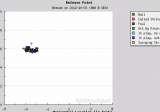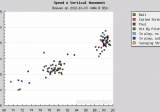.
Q. Is the Blake Fister pitching motion actually affecting the flight of the ball?
A. It has totally warped every breaking pitch in his arsenal. He now has three completely different breaking pitches from what he had in 2012.
But let's talk fastball. More groundballs, you ask? Blake's heater has changed thusly ...
Thanks to the gracious Brooks baseball site, here is the release point from October 3, 2012 below. Notice that the pitches cluster around the 5' 10" level:

Release point from March 17, 2013 below. The spread is from 6' up to nearly 7'... if you don't think it's hard to start shooting a basketball from a spot 9" higher, I suggest you try it sometime:

It's quite remarkable that Beavan was able to throw from such a warped release point, and yet command his fastball. I'd have predicted no way, Jose. But his command was pretty much normal.
Here is the horizonal "hop" from last year, an October 3, 2012 game against the Angels. Look at the top right cluster, the 88-92 MPH cluster. It shows a vertical rise that scatters from 1" hop to 9" hop:

Beavan's horizontal fastball "hop" from yesterday is pasted below. Are you sitting down?

.
Q. So he is indeed throwing from 6+ inches higher. Coming from a higher angle means what?
A. He is "hiding" the ball with front knee and glove, rocking back and connecting his shoulders more with the CF, and "throwing downhill." In a vacuum that gets the ball off the plane of the bat, generates better leverage, and creates a heavy fastball.
AS A GENERAL RULE, pitching coaches always tell you they love the high front side and the downhill motion. Undoubtedly it was part of what moved Fister to the head of the line back in his day. Remember Paul Abbott?
...........
As a general rule, the high front side adds deception. It therefore "lengthens" his fastball a little bit.
.
Q. What does it mean that he now has 10-11 inches of "hop" on the fastball?
A. Last year, Beavan had about 5 inches rise, which is the same thing as saying he had poor "hop." Typical MLB rise is 5" on a two-seam swerveball or 8" on a four-seam rising heater.
Beavan, yesterday, suddenly had 11" of hop -- which is getting more towards Stephen Pryor, Brandon Morrow hop.
.
Q. So why would that produce groundballs?
A. It would not.
.
Q. So why did he have groundballs?
A. Coincidence.
Also, Beavan does have a nice ability to get on batters' hands, where the thin part of the handle produces mis-hits. The grounders were pulled off the handle.
.
Q. He had added length from several directions, then.
A. Yes, he had a foot from the high front side. He had another foot from the hop. He had a third 12" from the lengthened front stride.
.
Q. So now he can throw the ball by people?
A. At no time did he throw the ball by anybody. They never even "cheated" to catch up to a pitch, not a single time.
But! There was a reason for that. ... Blake Fister's new, hoppier fastball should serve him well. Let's get into that under the change-speed post...
NEXT
Add comment